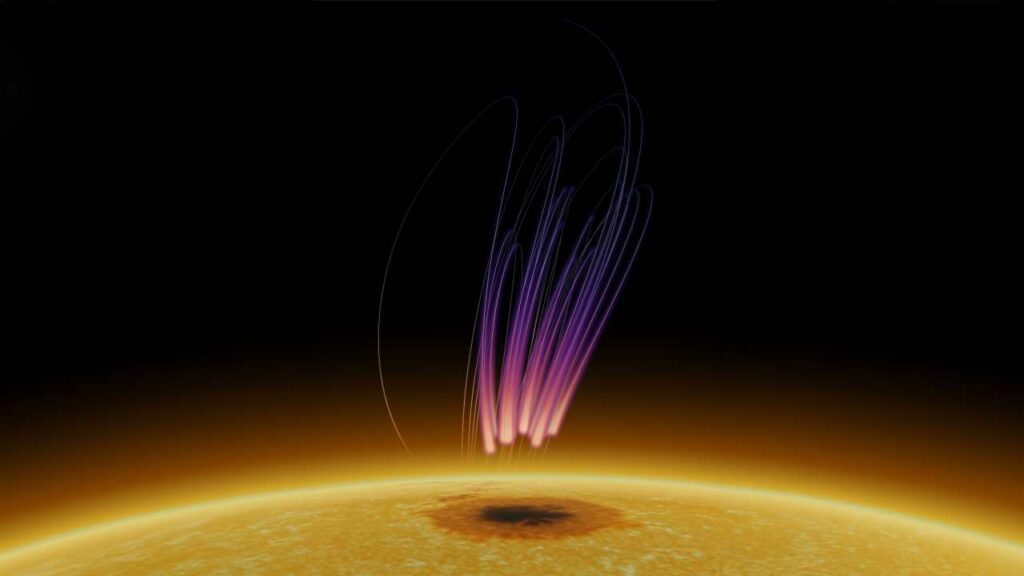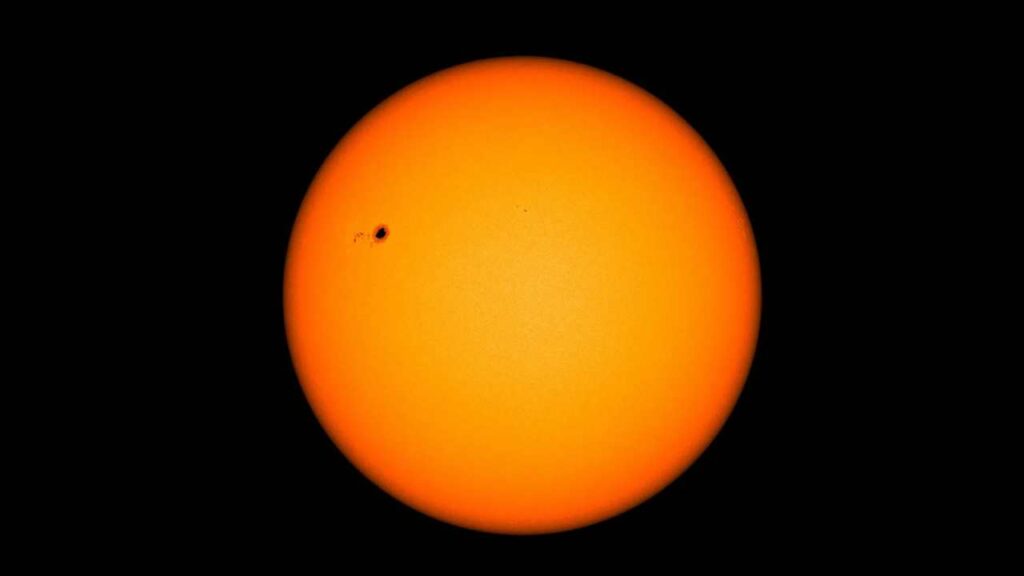“NASA, solar research, sunspots, radio emissions, aurora-like emissions, space weather, magnetic field dynamics, solar activity, Karl G. Jansky Very Large Array, stellar astronomy, space missions, NASA’s Discover of Aurora-Like Radio”
Dive into the heart of solar exploration with “Exploring the Sun’s Mysteries: NASA’s Discovery of Aurora-Like Radio Emissions,” where we unveil the recent groundbreaking discovery by NASA-funded scientists. This fascinating find highlights long-lasting radio signals from a sunspot, reminiscent of Earth’s mesmerizing auroras. Through this comprehensive overview, gain insights into how these emissions not only deepen our understanding of the Sun’s magnetic activities but also bridge connections to auroral phenomena on distant stars. Join us as we navigate through the implications of this discovery for solar physics, space weather forecasting, and our broader understanding of the universe.

Exploring the Sun’s Mysteries- The Impact of Aurora-Like Radio Emissions
In a groundbreaking study funded by NASA, scientists have unveiled a phenomenon on the Sun akin to the dazzling auroras seen on Earth. This discovery, detected by a team of researchers led by Sijie Yu from the New Jersey Institute of Technology, Newark, marks a significant leap in our understanding of the Sun and potentially, distant stars.
A First of Its Kind Discovery
The team identified unusual, long-lasting radio signals emanating from a sunspot, approximately 25,000 miles above the Sun’s surface. These radio bursts, previously witnessed only on planets and other stars, persisted for more than a week, a duration remarkably longer than the Sun’s typical short-lived radio emissions. Published in the January 2024 issue of Nature Astronomy, this research highlights the first detection of such sunspot radio emission.
The Science Behind the Phenomenon
Sunspots, known for their cool, dark, and magnetically active nature, have now revealed an even more fascinating aspect. The detected radio bursts share similarities with the radio emissions observed in the polar regions of Earth and other planets, where auroras occur. On Earth, auroras are produced when solar particles, trapped by the planet’s magnetic field, collide with atmospheric atoms, creating a spectacular light show.
Yu’s team proposes that the sunspot radio bursts arise through a similar mechanism, where energetic electrons are accelerated by the Sun’s magnetic fields. However, these bursts occur at significantly higher frequencies due to the sunspot’s much stronger magnetic field.
Implications for Astronomical Research
This discovery not only deepens our comprehension of the Sun’s behavior but also challenges existing notions of solar radio phenomena. It suggests that aurora-like radio emissions may originate from large spots on stars, expanding our understanding of magnetic activities beyond our solar system.
NASA’s Role and Future Prospects
The research, supported by a NASA Early Career Investigator Program grant, showcases the potential of NASA’s heliophysics fleet in investigating these mysterious radio bursts further. The Solar Dynamics Observatory, among other tools, will play a crucial role in monitoring the Sun’s active regions, likely uncovering more about this intriguing phenomenon.
Yu and his team plan to revisit previous solar radio bursts records to identify any similar aurora-like emissions, potentially rewriting some of the established narratives about solar radio activity.
Unlocking the Sun’s Magnetic Mysteries: Beyond Aurora-Like Radio Emissions
The recent discovery by a NASA-funded team, led by Sijie Yu from the New Jersey Institute of Technology, of long-lasting radio signals from a sunspot heralds a new chapter in solar research. This finding not only sheds light on phenomena akin to Earth’s auroras but also opens up discussions on the broader implications for solar physics and stellar astronomy.
The Complex Dynamics of Sunspots
Sunspots, the dark patches on the Sun’s surface, are sites of intense magnetic activity. Their appearance signifies the tangling, crossing, or reorganizing of magnetic field lines, phenomena that can lead to solar flares and coronal mass ejections. Understanding the radio emissions from these regions could provide new insights into the Sun’s magnetic field dynamics, offering clues about the processes that drive solar activity cycles and their impact on space weather.

Advancements in Solar Observations
The detection of these unique radio emissions was made possible by the sophisticated technology of the Karl G. Jansky Very Large Array in New Mexico. This highlights the importance of advanced observational tools in uncovering the secrets of our Sun. The continual development and deployment of high-resolution telescopes and observatories, both on Earth and in space, are crucial for the next steps in solar research.
Solar Activity and Space Weather
The study of sunspots and associated radio emissions is not just an academic pursuit. It has practical implications for understanding and forecasting space weather, which can have profound effects on satellite operations, communication systems, and power grids on Earth. Enhanced knowledge of solar phenomena allows for improved prediction models, potentially mitigating the adverse effects of solar storms on our technology-dependent society.
The Role of Computational Simulations
Beyond observational studies, computational simulations play a pivotal role in understanding the Sun’s magnetic activities. By simulating the conditions around sunspots and the generation of radio emissions, scientists can delve into the mechanics of these processes, testing theories and predictions against observed data. This synergy between observational and theoretical approaches is vital for advancing our comprehension of solar and stellar phenomena.
Interstellar Implications
The discovery also has implications for the study of stars beyond our solar system. By comparing the Sun’s radio emissions with those from other stars, astronomers can gain insights into the magnetic activities of distant stellar objects. This could inform us about the behavior of stars at different stages of their lifecycle and enhance our understanding of the galactic environment’s influence on planetary systems.
Future Endeavors in Solar Research
As the research community continues to explore the implications of this discovery, future missions and studies will likely focus on detailed monitoring of sunspots and their magnetic environments. Projects like the Parker Solar Probe and the upcoming European Space Agency’s Solar Orbiter mission are set to provide unprecedented views of the Sun, potentially unveiling more about the nature and origin of these intriguing radio emissions.
Conclusion
This NASA-funded discovery opens new avenues for exploring the magnetic activities of our Sun and beyond, challenging traditional understanding and promising exciting developments in the field of astronomy. As researchers continue to unravel the mysteries of these aurora-like radio emissions, we stand on the brink of deeper insights into the cosmos’s magnetic phenomena, bridging the gap between our star and the distant universe.
- NASA Juno Mission Reveals Oxygen Production Mysteries
- SpaceX-NASA Crew 8 Mission
- Total Solar Eclipse 2024
- NASA Telescopes Find New Clues About Mysterious Deep Space Signals










